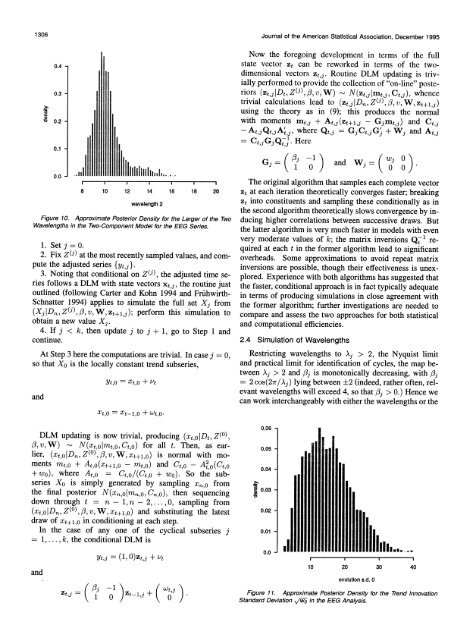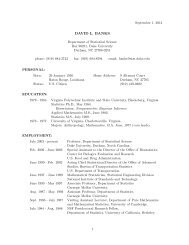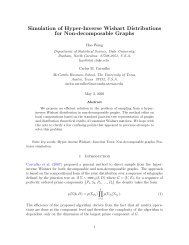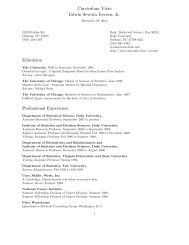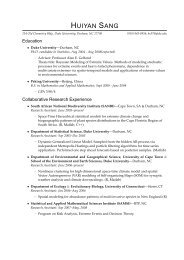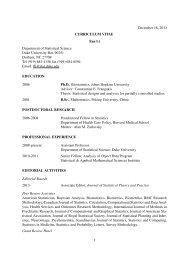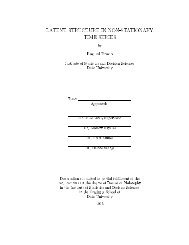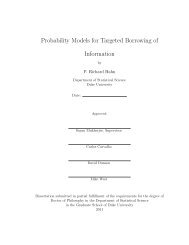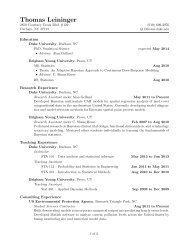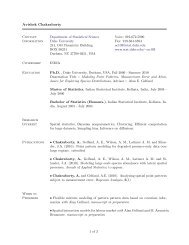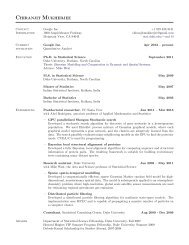Bayesian Inference in Cyclical Component Dynamic Linear Models
Bayesian Inference in Cyclical Component Dynamic Linear Models
Bayesian Inference in Cyclical Component Dynamic Linear Models
You also want an ePaper? Increase the reach of your titles
YUMPU automatically turns print PDFs into web optimized ePapers that Google loves.
1306 Journal of the American Statistical Association, December 1995<br />
Now the forego<strong>in</strong>g development <strong>in</strong> terms of the full<br />
0.4<br />
state vector zt can be reworked <strong>in</strong> terms of the twodimensional<br />
vectors zt,j. Rout<strong>in</strong>e DLM updat<strong>in</strong>g is trivially<br />
performed to provide the collection of "on-l<strong>in</strong>e" poste-<br />
0.3<br />
riors (zt,jjDt, Z U3, v, W) N(zt,jImt,j, Ct,j), whence<br />
trivial calculations lead to (zt,jID, ZU)A , v, W, Zt+l,j)<br />
us<strong>in</strong>g the theory as <strong>in</strong> (9); this produces the normal<br />
0.2-<br />
with moments mt,j + At,j(zt+i,j - Gjmt,j) and Ct,<br />
-Atj, Qt,j At , where Qt,j = Gj Ct,j G + Wj and At,<br />
= Ct,j Gj Q- 1. Here<br />
0.1<br />
Gj 1=(3 i0) and<br />
I, I1<br />
Wj =(j 0)<br />
I1 Il lll i Itl .. I I<br />
0.0 dI IIIIIIIIhh<br />
The orig<strong>in</strong>al algorithm that samples each complete vector<br />
8 10 12 14 16 18 20 zt at each iteration theoretically converges faster; break<strong>in</strong>g<br />
zt<br />
wavelength 2<br />
<strong>in</strong>to constituents and sampl<strong>in</strong>g these conditionally as <strong>in</strong><br />
the second algorithm theoretically slows convergence by <strong>in</strong>-<br />
Figure 10. Approximate Posterior Density for the Larger of the Two duc<strong>in</strong>g higher correlations between successive draws. But<br />
Wavelengths <strong>in</strong> the Two-<strong>Component</strong> Model for the EEG Series. the latter algorithm is very much faster <strong>in</strong> models with even<br />
very moderate values of k; the matrix <strong>in</strong>versions Q71 re-<br />
1. Set j = 0.<br />
quired at each t <strong>in</strong> the former algorithm lead to significant<br />
2. Fix Z() at the most recently sampled values, and com- overheads. Some approximations to avoid repeat matrix<br />
pute the adjusted series {Yt,j}.<br />
<strong>in</strong>versions are possible, though their effectiveness is unex-<br />
3. Not<strong>in</strong>g that conditional on Zi), the adjusted time se- plored. Experience with both algorithms has suggested that<br />
ries follows a DLM with state vectors xt,j, the rout<strong>in</strong>e just the faster, conditional approach is <strong>in</strong> fact typically adequate<br />
outl<strong>in</strong>ed (follow<strong>in</strong>g Carter and Kohn 1994 and Fruhwirth- <strong>in</strong> terms of produc<strong>in</strong>g simulations <strong>in</strong> close agreement with<br />
Schnatter 1994) applies to simulate the full set Xj from the former algorithm; further <strong>in</strong>vestigations are needed to<br />
(XjJ Dn, Z zU) 3, v, xW zt+?1,3); perform this simulation to compare and assess the two approaches for both statistical<br />
obta<strong>in</strong> a new value X .<br />
and computational efficiencies.<br />
4. If j < k, then update j to j + 1, go to Step 1 and<br />
cont<strong>in</strong>ue.<br />
2.4 Simulation of Wavelengths<br />
At Step 3 here the computations are trivial. In case j = 0, Restrict<strong>in</strong>g wavelengths to Aj > 2, the Nyquist limit<br />
so that Xo is the locally constant trend subseries, and practical limit for identification of cycles, the map between<br />
Aj > 2 and 3j is monotonically decreas<strong>in</strong>g, with 3j<br />
Yt,o = Xt,O + Vt<br />
= 2 cos(2ir/Aj) ly<strong>in</strong>g between +2 (<strong>in</strong>deed, rather often, relevant<br />
wavelengths will exceed 4, so that<br />
and<br />
3j > 0.) Hence we<br />
can work <strong>in</strong>terchangeably with either the wavelengths or the<br />
Xt,O = Xt- 1,0 + Wt,O<br />
0.06 -<br />
DLM updat<strong>in</strong>g is now trivial, produc<strong>in</strong>g (xt,o Dt IZ(O)<br />
3, v, W) -<br />
N(xt,oJmt,o, Ct,o) for all t. Then, as ear- 0.05<br />
lier, (xt,oJDn,Z(?),3,v,V, xt+1iO) is normal with moments<br />
mt,o + At,o(xt+?,o - mt,o) and Ct,o - A 2 o(Ct o<br />
0.04-<br />
+wo), where At,o = Ct,O/(Ct,O + wo). So the subseries<br />
Xo is simply generated by sampl<strong>in</strong>g xn,O from<br />
the f<strong>in</strong>al 0.03-<br />
posterior N(xn,oJMn,O, CT,O), then sequenc<strong>in</strong>g<br />
down through t = n - 1, n - 2,... , 0, sampl<strong>in</strong>g from<br />
(Xt,OJDn,Z(0)1)3,v,W,xt+?io) and substitut<strong>in</strong>g the latest 0.02-<br />
draw of xt+,,o <strong>in</strong> condition<strong>in</strong>g at each step.<br />
In the case of any one of the cyclical subseries j<br />
0.01<br />
= 1, ... , k, the conditional DLM is<br />
Yt,j = (1,0)zt,j+ Vt<br />
10 20 30 40<br />
and<br />
evolution s.d. 0<br />
Ztj= (pi; ~o1 )Ztil,3 ? (wti ) - Figure 11. Approximate Posterior Density for the Trend Innovation<br />
Standard Deviation +/i <strong>in</strong> the EEG Analysis.


